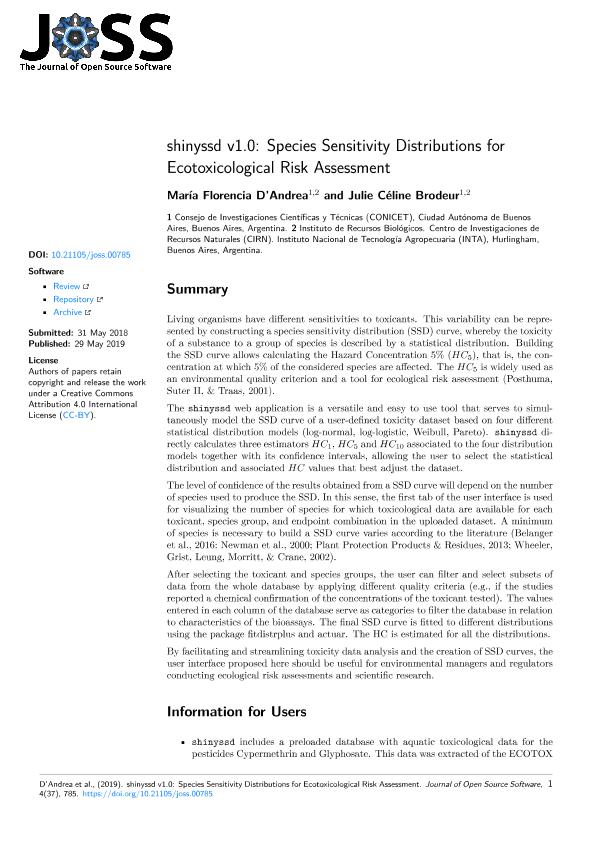Artículo
shinyssd v1.0: Species Sensitivity Distributions for Ecotoxicological Risk Assessment
Fecha de publicación:
05/2019
Editorial:
The journal of open science software
Revista:
Journal of Open Source Software
ISSN:
2475-9066
Idioma:
Inglés
Tipo de recurso:
Artículo publicado
Clasificación temática:
Resumen
Living organisms have different sensitivities to toxicants. This variability can be represented by constructing a species sensitivity distribution (SSD) curve, whereby the toxicityof a substance to a group of species is described by a statistical distribution. Buildingthe SSD curve allows calculating the Hazard Concentration 5% (HC5), that is, the concentration at which 5% of the considered species are affected. The HC5 is widely used asan environmental quality criterion and a tool for ecological risk assessment (Posthuma,Suter II, & Traas, 2001).The shinyssd web application is a versatile and easy to use tool that serves to simultaneously model the SSD curve of a user-defined toxicity dataset based on four differentstatistical distribution models (log-normal, log-logistic, Weibull, Pareto). shinyssd directly calculates three estimators HC1, HC5 and HC10 associated to the four distributionmodels together with its confidence intervals, allowing the user to select the statisticaldistribution and associated HC values that best adjust the dataset.The level of confidence of the results obtained from a SSD curve will depend on the numberof species used to produce the SSD. In this sense, the first tab of the user interface is usedfor visualizing the number of species for which toxicological data are available for eachtoxicant, species group, and endpoint combination in the uploaded dataset. A minimumof species is necessary to build a SSD curve varies according to the literature (Belangeret al., 2016; Newman et al., 2000; Plant Protection Products & Residues, 2013; Wheeler,Grist, Leung, Morritt, & Crane, 2002).After selecting the toxicant and species groups, the user can filter and select subsets ofdata from the whole database by applying different quality criteria (e.g., if the studiesreported a chemical confirmation of the concentrations of the toxicant tested). The valuesentered in each column of the database serve as categories to filter the database in relationto characteristics of the bioassays. The final SSD curve is fitted to different distributionsusing the package fitdistrplus and actuar. The HC is estimated for all the distributions.By facilitating and streamlining toxicity data analysis and the creation of SSD curves, theuser interface proposed here should be useful for environmental managers and regulatorsconducting ecological risk assessments and scientific research.
Archivos asociados
Licencia
Identificadores
Colecciones
Articulos(SEDE CENTRAL)
Articulos de SEDE CENTRAL
Articulos de SEDE CENTRAL
Citación
D'andrea, María Florencia; Brodeur, Celine Marie Julie; shinyssd v1.0: Species Sensitivity Distributions for Ecotoxicological Risk Assessment; The journal of open science software; Journal of Open Source Software; 4; 37; 5-2019; 1-3
Compartir
Altmétricas




